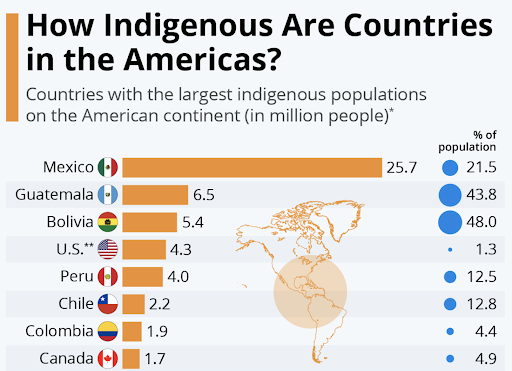Indigenous people – also referred to as first people, or aboriginal people – are native to their lands that have been settled or colonized by other ethnic groups. As the UN describes: “Indigenous people share a strong tie to their ancestral heritage and land. They may live there, or have been displaced from there, but the land and natural resources on which they depend are inseparably linked to their identities, cultures, and livelihood.”
Globally there are 476 million indigenous peoples living in 90 countries, accounting for 6.2% of the global population, traditions, languages and knowledge systems. They have a special relationship with their lands and hold diverse concepts of development based on their own worldviews and priorities. There are an estimated 5,0000 indigenous cultures around the world with the highest representation in Asia, followed by Africa. China has the world’s largest population of indigenous people: approximately 112 million people accounting for 8.5% of the population. They include Tibetans, Uyghurs, Zhuang and 52 other recognized groups.
Inequality and Exclusion: Indigenous Peoples worldwide have faced a legacy of inequality and injustice. Historically they have been displaced and exterminated. Today, they face multiple barriers to participating in formal economies: they do not have rights over their lands and natural resources, do not receive a fair share of public investments for basic services, have little or no access to education, nor do they participate in political processes and decision making. Furthermore, they often do not have access to the infrastructure available to others such as healthcare, clean water, sanitation, food security and other basic human rights.
Because of this exclusion, indigenous communities are more vulnerable to the impacts of climate change, natural hazards, and disease outbreaks. One of the greatest tragedies the Covid-9 pandemic is the high mortality rate among the indigenous elders; their loss signifies a loss of their culture and history , as elders hold their oral history and community memory.
Closer to home: As the United States was colonized by Europeans, Native Americans were displaced, slaughtered, and vilified. Their lands were repossessed by the colonizers, with ensuing battles between the colonizing pioneers and the “Indians” – a term coined by Christopher Columbus who thought he had arrived in the East Indes when he ‘discovered’ the Americas in 1492. Because of their dark skin, different language, lifestyle and spiritual beliefs, the colonizers (French, Spanish and British) thought of the Native Americans as inferior.
The US Government waged 1,500 battles against Native Americans, resulting in the death of millions of Native Americans by the 1900s. The number of Native Americans in the US was reduced to less than 240,000. This is the largest genocide of an indigenous people on the globe.
Native Americans in the US were deprived of all rights for centuries. Despite people ‘of all races’ being given the right to vote in 1860, Native Americans did not get the right to vote until 1924 with the Snyder Act.
In Canada, the Canadian Constitution recognizes three indigenous, or aboriginal peoples: the Native American peoples: Frist Nation (Indians), the Inuit, and the Métis. The Canadian Truth and Reconciliation Act of 2015 marked Canada’s official efforts at reconciliation, truth telling and healing.
The recent discovery of 1,100 indigenous children’s bodies in unmarked graves, highlighted the Catholic church’s rigorous residential schools programmed to ‘reform’ indigenous children using harsh, abusive measures. Children were separated from their families and their culture, in an attempt to wipe out the indigenous culture. It is estimated that approximately 15,000 indigenous children were killed. The last of these schools closed I 1996.
As members of the Organization of American States (OAS) both the United States and Canada ratified the American Declaration of Rights of Indigenous People in 2016, committing to addressing urgent issues of concern, including discrimination, violence and other basic human rights.
FAQs
- The oldest Native American tribe – the Clovis culture – were in North America over 13,000 years ago.
- When Columbus first came to North America there were an estimated 5 – 15 million Native Americans on the continent.
- 150,000 indigenous children were put in residential schools in the a century
- Indigenous people make up for 5% of the world’s population, but account of 15% of the world’s poverty.
- Overall poverty in the USA is 12.3 percent, however indigenous communities have a higher poverty rate of 25.4 percent.
- Indigenous peoples are nearly three times as likely to be living in extreme poverty compared to their non-indigenous counterparts.
What can you do? Create awareness: learn more about the history of indigenous people in your country. Explore indigenous cultures not only at home, but also when you travel. Advocate for indigenous peoples and their cultures. Support their political efforts and businesses.
Links:
- https://www.history.com/news/native-americans-genocide-united-states
- https://www.history.com/topics/native-american-history/native-american-timeline
- https://www.oas.org/en/sare/documents/DecAmIND.pdf
- https://www.theguardian.com/news/audio/2021/jul/09/indigenous-children-who-died-canada-residential-schools-podcast

